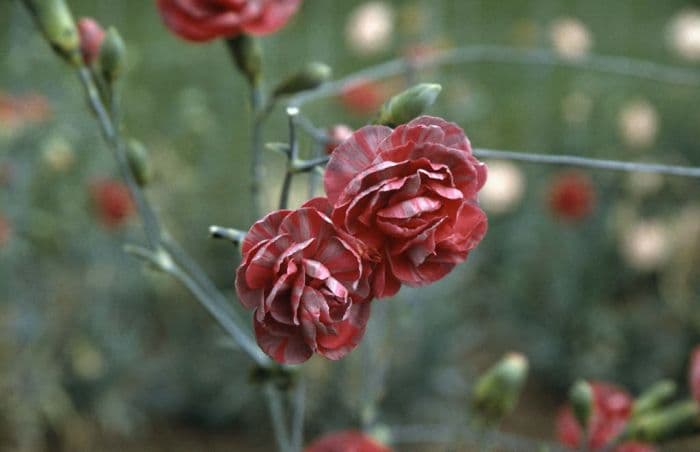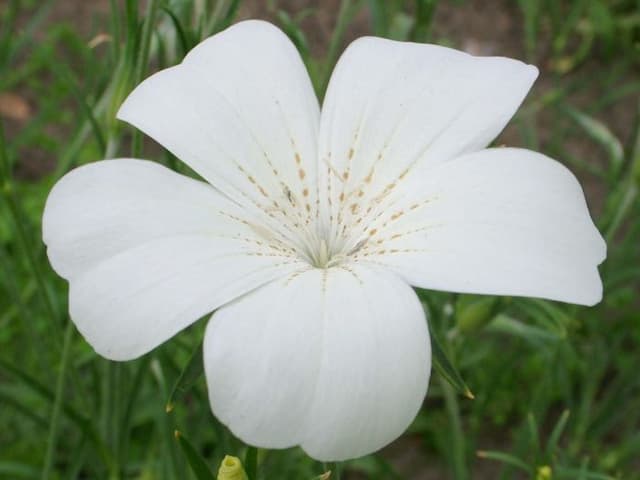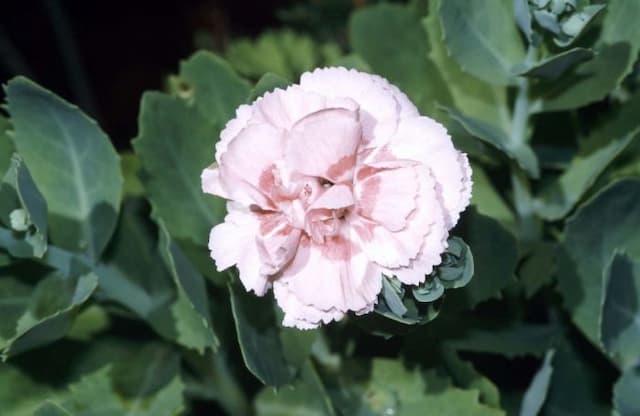Border carnation 'Eileen Neal' Dianthus 'Eileen Neal' (b)

ABOUT
'Eileen Neal' is a vigorous perennial with strongly clove-scented double flowers to 6cm across, the slightly fringed petals salmon-red with purple flecks
About this plant
 Names
NamesFamily
Caryophyllaceae
Synonyms
Carnation, Pink, Sweet William
Common names
Dianthus 'Eileen Neal'
 Characteristics
CharacteristicsLife cycle
Perennials
Foliage type
Evergreen
Color of leaves
Blue-green
Flower color
Pink
Height
1 foot 30 centimeters
Spread
1 foot 30 centimeters
Plant type
Herb
Hardiness zones
7
Native area
Europe
Benefits
 General Benefits
General Benefits- Attracts beneficial insects: The flowers of Dianthus 'Eileen Neal', also known as Pinks, attract pollinators like bees and butterflies, which are essential for the health of ecosystems.
- Aesthetic appeal: With its vivid colors and attractive form, Pinks add beauty to gardens and landscapes, enhancing the visual pleasure of an area.
- Fragrance: Pinks are well-known for their sweet fragrance, which can add a pleasant scent to gardens and outdoor spaces.
- Cutting garden plant: These flowers are excellent for cutting and creating bouquets, which can bring the beauty and scent of the garden indoors.
- Drought resistance: Once established, Pinks can be quite drought-tolerant, requiring less water and maintenance compared to many other garden plants.
- Long blooming period: Pinks often have a lengthy blooming period, providing color in a garden from spring to fall.
- Low maintenance: Being relatively easy to care for, Pinks do not require extensive gardening experience, making them suitable for many gardeners.
 Medical Properties
Medical PropertiesThis plant is not used for medical purposes.
 Air-purifying Qualities
Air-purifying QualitiesThis plant is not specifically known for air purifying qualities.
 Other Uses
Other Uses- Carnation 'Eileen Neal' petals can be used to create natural dyes for fabrics or paper, offering a range of pink and red hues depending on the mordant used.
- The flowers are edible and can add color and a light spicy flavor to salads, desserts, and drinks.
- Used in crafts, dried Carnation 'Eileen Neal' flowers can be incorporated into potpourri or sachets for a delightful fragrance.
- Carnation blooms can be pressed and used in botanical art, preserving their shape and color for decorative purposes.
- These flowers can serve as a natural pest deterrent in gardens due to their clove-like scent, which some pests find unappealing.
- Petals from Carnations can be used to make a colorful, delicate floral syrup for use in cocktails and other beverages.
- Whole Carnation 'Eileen Neal' blooms can be frozen in ice cubes to create an attractive and unexpected touch for special events and parties.
- The vivid colors of this Carnation can be captured in high-resolution photography for use in print or digital media as a representation of natural beauty.
- As a natural confetti, petals from the Carnation 'Eileen Neal' can be tossed at celebrations like weddings for an eco-friendly alternative to paper or plastic.
- The sturdy stems and long-lasting blooms make Carnations suitable for artistic floral arrangements, teaching floral design techniques to beginners and experts alike.
Interesting Facts
 Feng Shui
Feng ShuiThe Carnation is not used in Feng Shui practice.
 Zodiac Sign Compitability
Zodiac Sign CompitabilityThe Carnation is not used in astrology practice.
 Plant Symbolism
Plant Symbolism- Love: Dianthus flowers, commonly known as "pinks", are often associated with love and affection, making them a popular choice for romantic occasions.
- Fertility: With their prolific blooming habit, pinks can symbolize fertility and abundance.
- Boldness: The vibrant colors and spicy fragrance of pinks are indicative of boldness and adventurousness.
- Divine Love: The timeless and enduring nature of these flowers can represent divine or eternal love.
 Water
WaterCarnation 'Eileen Neal' requires regular watering to maintain moist, but not waterlogged, soil conditions. It is best to water the plant deeply once or twice a week, providing about one to one and a half gallons per week, depending on weather conditions and soil drainage. The method should be watering at the base of the plant to avoid wetting the foliage, which can lead to fungal diseases. During hot, dry periods, increase the frequency to ensure the soil does not dry out completely. Reduce watering in the winter when the plant is not actively growing.
 Light
LightCarnations in general thrive in full sun conditions, and the 'Eileen Neal' variety is no exception. The ideal spot for this dianthus should receive at least six hours of direct sunlight daily. Partial shade is tolerated but may reduce the plant’s vigor and blooming capacity. Avoid too much shade, as it can lead to poor growth and increased susceptibility to disease.
 Temperature
TemperatureThe Carnation 'Eileen Neal' can survive in a range of temperatures but performs best in cooler conditions. It prefers a temperature range of 60-70°F during the day, dropping 10-15 degrees at night. The plant is hardy and can survive temperatures as low as freezıng, but prolonged exposure to temperatures below 20°F may damage or kill the plant. Ideal growing conditions are cool to moderate temperatures with good air circulation.
 Pruning
PruningPruning Carnation 'Eileen Neal' is important for promoting vigorous growth and prolific flowering. Deadhead spent flowers regularly to encourage more blooms. In the spring, trim back the plant to about one-third of its size to remove old growth and shape the bush. It's best to prune carnations after their first significant bloom, usually in the late spring or early summer, to ensure a second flush of flowers.
 Cleaning
CleaningAs needed
 Soil
SoilCarnations, such as 'Eileen Neal', thrive in well-draining, loamy soil with a pH of 6.0–7.5. A mix of two-thirds garden soil and one-third coarse sand or perlite is ideal. Add compost for fertility.
 Repotting
RepottingCarnations typically require repotting every two to three years or when they outgrow their current container. It's best done in spring before new growth starts.
 Humidity & Misting
Humidity & MistingCarnations like 'Eileen Neal' prefer moderate humidity levels, avoiding excessively dry or moist air. Aim for humidity levels between 40-60%.
 Suitable locations
Suitable locationsIndoor
Place carnations in bright, indirect light; avoid overwatering.
Outdoor
Choose a sunny spot, protect from strong winds, ensure good drainage.
Hardiness zone
3-9 USDA
 Life cycle
Life cycleDianthus 'Eileen Neal', more commonly known as Pinks, begins its life cycle when seeds are sown, generally in late spring or early summer, after the last frost. The seeds germinate and develop into seedlings, which will then establish a root system and begin to produce their first true leaves. As the plant matures, it enters a vegetative phase where it grows stems and foliage, forming a compact, mound-shaped clump. Flowering occurs from late spring through summer when the Pinks produce their fragrant, showy flowers, attracting pollinators to the garden. After blooming, if the flowers are left to pollinate and fade, they can produce seeds which can be collected or allowed to self-sow. During the winter or in colder climates, Pinks may die back, entering a period of dormancy, but with proper care, they can survive and re-emerge the following spring to continue their life cycle.
 Propogation
PropogationPropogation time
Spring to Summer
The Dianthus 'Eileen Neal', commonly known as 'Pink', is typically propagated through the method of cuttings, which is often considered the most popular method for this plant. The best time to take cuttings for propagation is late spring through early summer when the plant has ample growth and the temperatures are warm enough to encourage root development. To propagate by cuttings, one should select a healthy, non-flowering stem and cut a piece about 4 to 6 inches (approximately 10 to 15 centimeters) long. The lower leaves are then removed, and the cut end is dipped in rooting hormone to facilitate root growth. This cutting is then planted in a well-draining soil mix, ensuring that at least two nodes are buried where leaves were removed. The soil should be kept consistently moist, and the cutting should be placed in a location with bright, indirect light. Roots typically develop within a few weeks, and once established, the new plant can be transplanted to a permanent location.








![Pink [Bubblegum]](/_next/image?url=https%3A%2F%2Fplants-admin.emdemapps.com%2Fimages%2Fplants%2F%2Fimages%2F604b596f31cbb.png&w=640&q=75)
